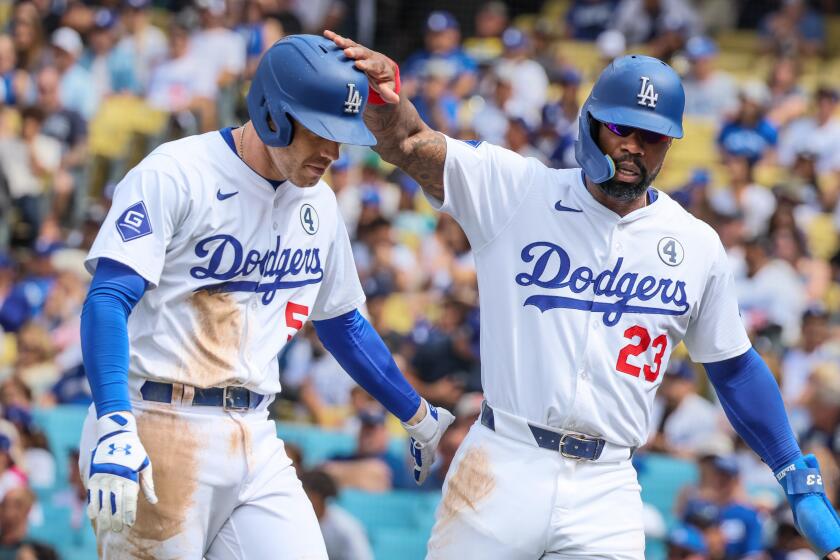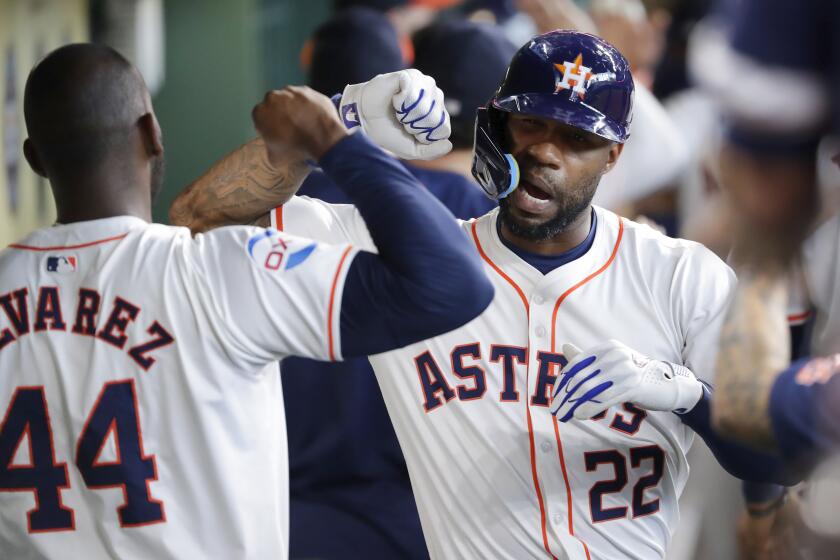Extra Innings : Nostalgic Fans to Honor Minor League Field That Is Now Site of TV Studio
Baseball historian Larry Zuckerman felt right at home.
“Here’s where it was,” he announced, tucking old maps and fading photos under his arm and pointing to the middle of a driveway at the back door of one of Hollywood’s busiest television studios. “This is the spot.”
Preparing to commemorate Gilmore Field with a plaque this weekend, 40 years after the last pitch was thrown toward the demolished baseball stadium’s home plate, Zuckerman had scored.
Crinkled stadium construction blueprints from 1939 had revealed details of the field itself (center-field scoreboard: 18 feet high; left field fence: 348 feet from home plate; bleacher seats: six feet from the right field line). Agate type from the yellowed sports pages of old Los Angeles newspapers had told details of the stadium’s final game, Sept. 5, 1957 (Hollywood 6, San Francisco 0).
But when baseball fans decided to honor the colorful old minor league field, it took old insurance company maps, a handful of aging photographs and a tape measure for Zuckerman to find exactly where the Fairfax district stadium was.
CBS Television City’s Studio 46 now stands where the wood-and-steel grandstand once attracted crowds of up to 12,500 until the Dodgers brought major league baseball to Los Angeles in 1958.
Television fans now line up for studio audience seats near the onetime stadium entrance, where ball fans filed through turnstiles to $2 box seats and 25-cent left field bleacher spots.
The site is where former players for the Hollywood Stars and fans of the Pacific Coast League will gather Sunday at 1 p.m. to unveil a bronze plaque and a pair of photographs depicting Gilmore Field in its heyday.
The plaque will go on the studio wall. And this week, after Zuckerman, of Sherman Oaks, revealed where home plate was, CBS officials promised to bury a plexiglass-covered home plate in the studio driveway where bats were swung during 1,700 Hollywood Stars games.
Sunday’s ceremonies have been organized by the Pacific Coast League Historical Society, a decade-old group with 780 members. About 10 former players are expected to attend; former Stars manager Bobby Bragan, first baseman Chuck Stevens and umpire Cece Carlucci plan to speak.
“The ballclub and ballpark are a very important part of baseball history in Southern California,” said Dick Beverage, a Placentia financial consultant who heads the society. “The club fascinated a lot of people. It had a certain aura about it, with movie stars at games all the time.”
Celebrities such as Robert Taylor, Al Jolson, Bing Crosby, Gary Cooper, George Burns and Gracie Allen helped pack the place on opening day in 1939 as actress Gail Patrick threw out the ceremonial first pitch. Catching was comic Martha Raye. Batting was Jack Benny.
*
Oilman Earl Gilmore had built the baseball field for $200,000 across Genesee Avenue from a football stadium and midget car racetrack he had constructed five years earlier at the southeast corner of Beverly Boulevard and Fairfax Avenue.
Fans had high regard for both the stadium and the ballplayers.
“It wasn’t like Dodger Stadium. At Gilmore Field, you were close to the action, within 40 or 50 feet. You felt like you were part of the action,” said Bob Reiss, a 49-year-old Los Alamitos manufacturing company executive who grew up near the stadium and attended games regularly.
The Stars were owned by Brown Derby restaurant proprietor Bob Cobb. The triple A team was a Pittsburgh Pirates farm club. Most of its players had just been sent down from the majors--or were on the verge of being promoted to the big leagues. A rival minor league team, the Los Angeles Angels, played at the now-demolished Wrigley Field in South-Central Los Angeles.
“They played high-quality ball. Back in those days, minor league players got paid as much as players in the majors. They were professionals who preferred living on the West Coast instead of back East,” Reiss said.
Larry Rubin, a municipal judge in Santa Monica, said the intimacy of Gilmore Field fostered closeness between players and fans.
“I have very clear memories of sitting at the ballpark and talking with players in the bullpen,” he said.
“I remember buying photos of the 1957 players for a buck or two and sneaking down to the Hollywood dugout and showing them to” one of the players, he said. “He took them from me and was showing them to other players and ribbing them. I’m 51 now, and that took place 40 years ago when I was 11. Those kinds of memories stick with you.”
Rubin, who like Reiss is a member of the historical society, contacted CBS officials when the group decided to commemorate the old ball field. He also scored in an unexpectedly big way: The property manager for the sprawling CBS complex turned out to be a former Hollywood Stars fan.
“Hell, yes, I went to games here,” said Joel Chance, director of facilities for Television City. “My dad used to drive me up here for games all the time from Compton, where we lived.”
On Wednesday, Chance, 55, of Long Beach, showed Zuckerman and Reiss where the plaque will be installed as a crowd of young people waited to enter Studio 46 to watch the taping of the TV show “Vibe.”
None of those in the line had ever heard of Gilmore Field--although Anthony McKinley, 28, of Long Beach knew about the Hollywood Stars. He said he was impressed to learn he was standing near the stadium’s old entrance.
Zuckerman, a 54-year-old social worker, took Chance and Reiss behind the studio to find home plate. He told Chance that the society would like to mark the spot with a permanent home plate.
“You make it up and we’ll sink it,” promised Chance.
A final homer for Gilmore Field.
More to Read
Are you a true-blue fan?
Get our Dodgers Dugout newsletter for insights, news and much more.
You may occasionally receive promotional content from the Los Angeles Times.










